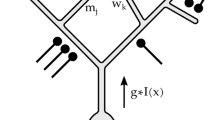Abstract
In the Type I receptive fields (RFs) changes of the luminance leads to a shift of the curve relating the response and the stimulus area along the abscissa, in the Type II RFs the maximum of a response does not shift with changes of the luminance (Types I and II on classification by Glezer et al., 1971, 1972). The transient responses were observed in the Type I RFs and sustained responses in the Type II RFs. In the Type I RFs variation of the stimulus area and intensity brings about the change in the temporal and spatial frequency characteristics. This is produced by functional reorganization of the RF. In the Type II RFs there is no functional reorganization. The data obtained indicate that the Type I RFs are non-linear. By contrast, the Type II RFs are linear systems. The analysis of the model has shown that the distinctions in the dynamic characteristics of the responses of RFs belonging to different types is mainly due to different time constants for excitation and inhibition as well as inhibition coefficients. Distinctions in the mode of dependence of the RF response on stimulus parameters have been found to result from different relationship between delay time and stimulus parameters as well as different forms of the spatial weighting functions. It is shown that the Type I RFs transmit higher frequency components of the image spectrum, i.e. they emphasise the temporal and spatial contrasts. The Type II RFs transmit low frequency components of the spectrum including information about the intensity of an input stimulus.
Similar content being viewed by others
References
Besekerskii,V.A., Popov,E.P.: The theory of automatic control systems. Leningrad: Nauka 1966 (In Russian)
Burke,W., Sefton,A.J.: Inhibitory mechanisms in lateral geniculate nucleus of rat. J. Physiol. 187, 231–246 (1966)
Cleland,B.G., Dubin,M.W., Levick,W.R.: Sustained and transient neurones in the cat's retina and lateral geniculate nucleus. J. Physiol. 217, 473–496 (1971)
Cooperman,A.M., Glezer,V.D.: A model for the relationship between the visual acuity and luminance and optical properties of the eye. Biofizika 19, 157–161 (1974) (In Russian)
Dreher,B., Fukada,Y., Rodieck,R.W.: Identification, classification, and anatomical segregation of cells with X-like and Y-like properties in the lateral geniculate nucleus of oldworld primates. J. Physiol. 258, 433–452 (1976)
Dudkin,K.N., Bedrov,Ya.A., Gauselman,V.E.: The types of the lateral geniculate body receptive fields and their frequency characteristics. Biofizika 21, 153–160 (1976) (In Russian)
Dudkin,K.N., Gauselman,V.E.: Recording and processing of the neuron responses to administration and removal of a stimulus. J. Physiol., SSSR 58, 1312–1317 (1972) (In Russian)
Dudkin,K.N., Gauselman,V.E.: A model for signal processing in the neuronal pools of the glomerula type in the Lateral Geniculate Body of the visual system. Biofizika 18, 715–723 (1973) (In Russian)
Dudkin,K.N., Glezer,V.D.: An investigation of the neurophysiological mechanisms of the brightness scale. Physiol. J. SSSR 61, 716–724 (1975) (In Russian)
Dudkin,K.N., Glezer,V.D., Gauselman,V.E.: Types of the Lateral Geniculate Body receptive fields and their functional model. Neurofisiologia 7, 27–34 (1975) (In Russian)
Dudkin,K.N., Sperl,L.V.: Construction of the post-stimulus histograms with the aid of analyser “Neuron-1”. Physiol. J. SSSR 58, 1535–1538 (1972) (In Russian)
Enroth-Cugell,C., Robson,S.G.: The contrast sensitivity of retinal ganglion cells of the cat. J. Physiol. 187, 517–552 (1966)
Enroth-Cugell,C., Shapley,R.M.: Flux, not retinal illumination is what cat retinal ganglion cells really care about. J. Physiol. 233, 311–326 (1973)
Glezer, V.D.: The receptive fields of the retina. Thesis, Leningrad, 1962 (In Russian)
Glezer,V.D., Dudkin,K.N., Ivanov,V.A., Kulkov,A.P.: On the signal coding by the neurons of the visual system. In: Principle of information processing in the visual system. Leningrad: Nauka 1970 (In Russian)
Glezer,V.D., Dudkin,K.N., Cooperman,A.M., Leushina,L.I., Nevskaya,A.A., Podvigin,N.F., Prazdnikova,N.V.: Visual recognition and its neurophysiological mechanisms. Leningrad: Nauka 1975 (In Russian)
Glezer,V.D., Ivanov,V.A., Tsherbach,T.A.: Functional changes in the LGB receptive fields of the cat. Physiol. J. SSSR 58, 131–137 (1970) (In Russian)
Glezer,V.D., Ivanov,V.A., Tsherbach,T.A.: Receptive fields of the Lateral Geniculate Body of the cat. Neurofisiologia 3, 131–137 (1971) (In Russian)
Glezer,V.D., Podvigin,N.F., Cooperman,A.M., Ivanov,V.A., Tsherbach,T.A.: Investigations of receptive fields of cat's corpus geniculatum lateralis. Structural and functional model of the field. Vision Res. 12, 2071–2107 (1972)
Hickey,T.L., Winters,R.W., Pollack,J.G.: Center-surround interactions in two types of on-center retinal ganglion cells in the cat. Vision Res. 13, 1511–1526 (1973)
Hochstein,S., Shapley,R.M.: Quantitative analysis of retinal ganglion cell classifications. J. Physiol. 262, 237–264 (1976)
Hochstein,S., Shapley,R.M.: Linear and non-linear spatial subunits in Y cat retinal ganglion cells. J. Physiol. 262, 265–287 (1976)
Hoffman,K.P., Stone,J., Sherman,S.M.: Relay of receptive-field properties in dorsal lateral geniculate nucleus of the cat. J. of neurophysiol. 35, 518–531 (1972)
Jones,E.G., Powell,T.P.S.: An electron microscopic study of the mode of termination of corticothalamic fibers within the sensory relay nuclei of the thalamus. Proc. Roy. Soc. Ser. B 172, 173–185 (1969)
Kalil,R.E., Chase,R.: Corticofugal influence on activity of lateral geniculate neurons in the cat. J. Neurophysiol. 30, 459–474 (1970)
Rodieck,R.W., Stone,J.: Analysis of Receptive fields of cat retinal ganglion cells. J. Neurophysiol. 28, 833–849 (1965)
Saito,H., Shimahara,T., Fukada,Y.: Four types of responses to light and dark spot stimuli in the cat optic nerve. Tohoku J. Exp. Med. 102, 127–133 (1970)
Singer,W., Creutzfeldt,O.D.: Reciprocal lateral inhibition of On-and Off-center neurons in the lateral geniculate body of the cat. Ex. Brain Res. 10, 311–330 (1970)
Sperling,G.: Model of visual adaptation and contrast detection. Percept. Psychophys. 8, 143–156 (1970)
Stockham,T.G.: Image processing in the context of a visual model. Proceedings of the IEEE, v. 60, 7, 828–842 (1972)
Szentagothai,J., Hamori,J., Tönhöl,T.: Degeneration and electron microscope analysis of the synaptic glomerula in the lateral geniculate body. Exp. Brain Res. 2, 283–305 (1966)
Tikhonov,A.N.: Calculating methods and programming. 8, Moscow University, Moscow, 1967 (In Russian)
Author information
Authors and Affiliations
Rights and permissions
About this article
Cite this article
Dudkin, K.N., Glezer, V.D., Gauselman, V.E. et al. Types of receptive fields in the lateral geniculate body and their functional model. Biol. Cybernetics 29, 37–47 (1978). https://doi.org/10.1007/BF00365234
Received:
Issue Date:
DOI: https://doi.org/10.1007/BF00365234



